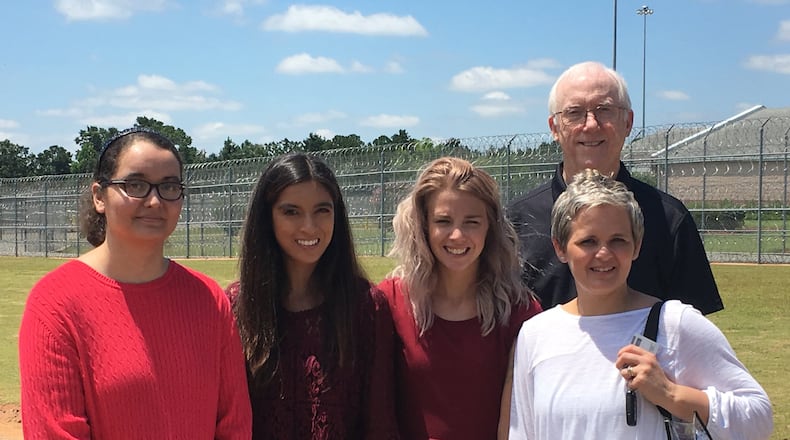Women remain the fastest-growing segment of the prison population. Some would even argue they are also the most vulnerable.
And yet stories about mass incarceration rarely, if ever, make mention of them.
I’ve done some piecemeal reporting on my own, about the impact incarceration has on their children, about programs that seek to reunite them.
Sometimes from the perspective of the prisoner, other times from the kid’s perspective but never from one who has been sentenced to life.
In “Women Lifers: Lives Before, Behind, and Beyond Bars,” we get a glimpse of that world in over 220 interviews with women serving life in Georgia prisons and it ain’t pretty.
In my mind, it is both sad and sadly troubling, starting, not surprisingly, with the overriding narrative that these women are so mean they are beyond redemption.
Meredith Huey Dye and Ronald H. Aday, the Middle Tennessee State University sociology professors who wrote the book, are hoping to not only change that narrative but raise awareness about what they consider excessively long sentences and inflexible parole boards that are counterproductive to public safety and a violation of these women’s rights.
Aday talked to me about the book awhile back, and I wanted to explore it and the plight of the women further.
RELATED | Making prison visitations more family-friendly
“Women Lifers” offers us, perhaps for the first time, a close-up of these women’s lives, what brought them to prison, how they have coped, and their hopes and dreams of returning one day back to their families.
We meet, among others, a 40-year-old at Lee Arrendale State Prison who at age 15 was party to felony murder, committed by her older, abusive boyfriend, and who insists she is “no longer that girl.” She has successfully completed as much education and as many programs as available to her and is hopeful of getting a second chance.
We meet the single, working mom whose kid died at the hands of her abusive boyfriend. He is out, but 30 years later, she is still serving time for murder.
And we meet a career woman who, until her husband “disappeared,” lived what seemed to be the perfect life. Although she accepts full responsibility for his murder and was sent to prison at age 53, she says she silently endured years of abuse. She says, “I was in prison even then.”
If she gets out, she will be 70 or 80 years old, when reentering society will be extremely difficult. Not only will she likely be too frail to work, she will have little to no retirement or savings, no Social Security, few remaining known family members to help.
Most people will feel no empathy for these women. They will ask, “What about the victims?”
But in many instances, prisons are turning into nursing homes with taxpayers footing the bill.
As older prisoners’ minds and bodies fail them and they grow infirm, the cost of health care can be two to three times more expensive. The typical lifer costs well in excess of $1 million for a 30- or 40-year sentence.
That’s a lot of money. The question is should we be forced to continue paying it?
Aday and Dye maintain, and it’s hard to argue the point, that keeping people locked up for years well beyond an eligible parole date serves little purpose other than extending retribution and increasing prison health care budgets.
Aday told me he came to this work 40 years ago when he began studying aging prisoners. When Dye arrived on campus in 2008, the two joined forces, delving into the lives of women who’d been sentenced to life.
What they found was startling.
RELATED | Georgia prison population, costs on rise
Besides the extreme costs of housing elderly prisoners, holding onto prisoners long after they’ve served the suggested number of years is now the norm.
Why? Indeterminate sentencing policies where 30 years to life often results in more than the minimum, with parole boards making the final judgment of how long is long enough.
The only reason to do that, Aday said, is pure retribution.
According to the National Institute of Justice, prisoners over age 50 are the fastest-growing population in federal and state prisons. This group now totals 292,272 and is expected to double by 2030. The annual budget to house and care for elderly prisoners is estimated at $16 billion and is expected to soar with increased end-of-life medical issues.
“Keeping people locked up until they reach a point of no return and their declining health interferes with the ability to successfully reintegrate back into society is a costly option that policymakers will need to consider in future prison reform discussions,” Aday said.
Similar to national trends, a disproportionate number of women serving life in Georgia — 55% — are women of color, many of them black women; 95% have no prior prison sentence and 83% had experienced violent rapes, bruises, broken bones, and frequent threats on their lives.
In addition, many of the women they interviewed were incarcerated when societal attitudes toward domestic violence were more tolerant and an abusive past was a less viable defense.
“Police were often reluctant to get involved, often leaving the women to fend for themselves — and in numerous situations the women felt they had to kill in self-defense in order to save their own life and the lives of their children,” Aday told me.
As our nation has become much tougher on criminals in general, there has been a trend toward putting women in prison and giving them longer sentences.
Let’s look at the numbers: There are more than 110,000 women in state and federal prisons. Of those, 3,917 are housed in Georgia institutions, the sixth-highest in the country. Nationwide, 1 of every 15 incarcerated women is serving a life sentence, and in Georgia, the women lifer population numbers 437, or 1 in 8. The average age of the woman lifer in Georgia is 45, with 35% being over age 50.
“We’re not trying to excuse the women or say they are innocent or be easy on them,” Dye said.
What they are saying is their stories are important, remarkable tales of courage, dignity and perseverance in the face of great obstacles.
They are telling us these are human beings who deserve to be heard. Not forgotten.
Find Gracie on Facebook (www.facebook.com/graciestaplesajc/) and Twitter (@GStaples_AJC) or email her at gstaples@ajc.com.
About the Author
Keep Reading
The Latest
Featured





